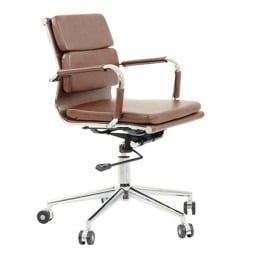Castors vs Gliders on Office Chairs: What is the Difference?
Welcome to the Lakeland Furniture blog, where you’ll find handy guides and advice on seating styles, trends, fabrics, and design. Looking for inspiration or information on bar stools, dining chairs, and office chairs? You’re in the right place.
Ready to find your perfect seating? Explore our Buying Guide.

What is the difference: castors vs gliders on office chairs
When shopping around for office chairs, you may find yourself confused as to which type to go for. Leather or fabric? Arms or no arms? Plain black or brightly coloured? All of these options are down to personal preference, really. But what about the more technical details? If you've heard the words 'castors' or 'gliders' thrown about on product description pages, you're probably wondering what they're all about. And that's where we come in. In this blog post, we'll clear up what the two features are and how they will affect your decisions about buying office chairs.
Castors vs gliders- But what are they?
Essentially, castors are wheels that are fixed to the bottom of a chair's legs to help it move around. On the other hand, gliders are metal or plastic discs fixed to the bottom of a chair's legs. These are meant to help a chair 'glide' across the floor. However, we believe that a glide is actually more like a standard foot on a chair, just with more protection when dragging along the floor. Castors, i.e. wheels, are much smoother upon movement, as you can probably imagine. Glides tend to have rounded edges which make movement a little softer but they aren't made for constant rolling across floors. We should also mention that there are different types of castors. And of course, they are much more common than gliders so it's worth delving deeper into.
Different types of castors
The first type of castor you might come across is 'charge-braked' or 'brake-loaded'. This is where the chair can be moved freely until any weight is applied. Then, the castor is locked and will act as a brake or a glide. This is helpful in supermarkets or factories where chairs need to be moved until the worker is sat on them. Another type of castor is 'interval-braked' or 'brake-unloaded'. This is where there is a slight brake on the wheels and then when weight is applied the brake is still present. Interval-braked castors are a safety measure for hard floors like concrete or vinyl where the chair could easily slip away. Lastly, another type of castor you might find (and actually the most common for office chairs) is 'free-wheeling'. Essentially, this is a wheel without a brake. Users are free to roll around with complete ease. These castors are usually found in offices and on carpeted floors.
castors vs gliders
Of course, it's ultimately up to you which mechanism will work best. Now you are armed with the knowledge, you can assess what type of office chair is going to be more efficient. For boardrooms, glides are quite common to prevent people from moving about too much during meetings. Whereas in relaxed office environments, castors are helpful to allow free movement from desk to desk. If you're ready to take a look at some office chairs, don't hesitate to check out our extensive range of products!


Do you now know a little more about the 'castors vs gliders' debate?
Let us know in the comments if this blog post helped you! We love to hear how our articles help our readers and customers. And if you feel a little wiser after reading, then our job here is done.
 30 day returns
30 day returns 2000+ reviews
2000+ reviews

Comments